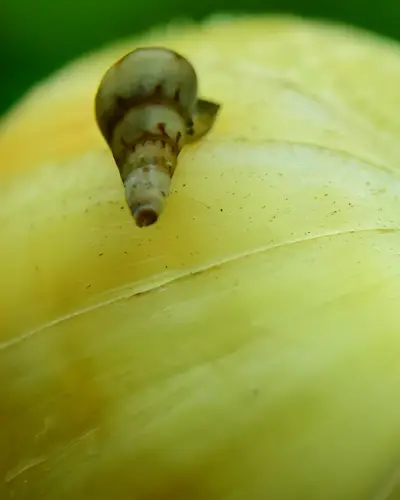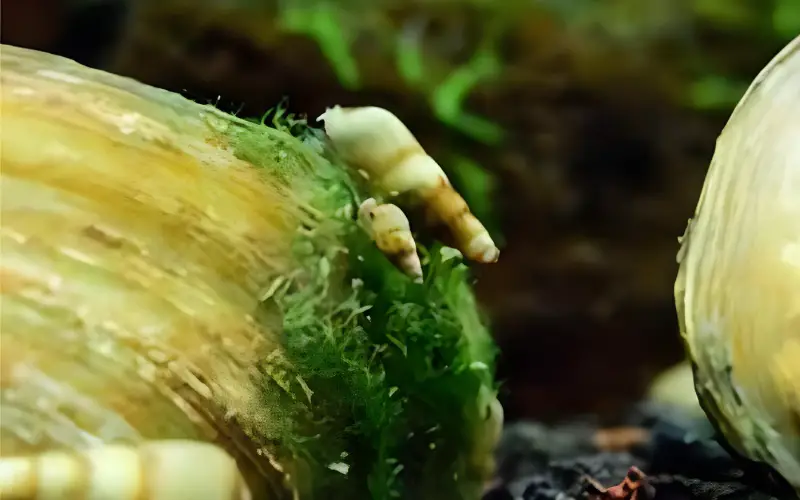With their graceful movements and tireless cleaning habits, Malaysian Trumpet Snails are a welcome addition to many freshwater aquariums. But a question often arises: what do Malaysian Trumpet Snails eat? The answer is more diverse than you might think!
While renowned for their algae-munching abilities, these snails have a varied palate.
In this guide, we’ll delve into the fascinating world of the Malaysian Trumpet Snail’s diet, exploring their food preferences, dietary needs, and even a few surprising snacks they enjoy.

Get ready to uncover the secrets behind these underwater vacuum cleaners and discover how to keep them happy and well-fed in your aquarium.
Table of Contents
ToggleWhat Do Malaysian Trumpet Snails Eat?
Malaysian trumpet snail what do they eat? Malaysian Trumpet Snails are renowned for their appetite for algae and leftover debris, making them efficient and valuable members of a freshwater aquarium’s clean-up crew.
Their diet primarily consists of:
- Algae: These snails are voracious algae eaters, consuming various types of algae, including soft green algae, brown diatoms, and even some hair algae.
- Uneaten Fish Food: They happily scavenge any fish food that sinks to the bottom, such as flakes, pellets, and bottom feeder tablets.
- Detritus and Debris: Malaysian Trumpet Snails are excellent at cleaning up organic matter, including decaying plant matter, leftover food particles, and residual residue on the substrate.
- Algae Wafers: While they primarily consume naturally occurring algae, supplemental algae wafers can be offered as a treat or to ensure they have enough to eat.
- Vegetables: Occasionally, they may nibble on blanched vegetables like zucchini or spinach, adding variety to their diet.
It’s important to note that while Malaysian Trumpet Snails are not picky eaters, they thrive on a balanced and varied diet. Providing them with a mix of algae, leftover fish food, and occasional supplements ensures they receive the necessary nutrients to maintain their shells and overall health.
Malaysian Trumpet Snail Care Is Easy
Malaysian trumpet snail care is easy for aquatic hobbyists as these tropical fish are low-maintenance. These live, plant-loving snails can be kept in a community tank with other peaceful fish like clown loaches or cichlids. Malaysian Trumpet Snails (MTS) are great for planted tanks as they help recycle nutrients and aerate the substrate.

These burrowing snails are also beneficial in controlling the population of other pond snails or ramshorn snails. Despite their name, Malaysian trumpet snails are not aggressive like assassin snails or mystery snails. They can thrive on algae-eating and leftover fish food. However, they can reproduce quickly, so it’s essential to monitor their population to prevent it from getting out of control.
One advantage of having Malaysian Trumpet Snails in your tank is that they help keep it clean by eating any small snails, such as nerite or ramshorn snails, that may also be present. These snails burrow in the substrate, preventing any dead spots from forming. However, some fish, like puffers or loaches, are natural snail eaters and may prey on Malaysian Trumpet Snails.
If you have these fish in your tank, finding ways to protect the snails or provide them with enough hiding spots is best. If you have a snail infestation, getting a few Malaysian Trumpet Snails from a pet store can help control the population and eliminate unwanted snail shells.
Malaysian Trumpet Snail Tank Mates: Peaceful Coexistence
Malaysian Trumpet Snails are peaceful and non-aggressive, making them ideal tank mates for various peaceful aquatic creatures.
Here are some excellent tank mate options:
Fish:
- Small, peaceful fish: Tetras, Rasboras, guppies, mollies, platies, and Corydoras catfish are all compatible with Malaysian Trumpet Snails.
- Shrimp: Cherry, Amano, and ghost shrimp cohabitate well with these snails.
- Other Snails: Mystery, Nerite, and Ramshorn snails can share the tank without issues.
Avoid:
- Aggressive fish: Cichlids, Oscars, and other large or aggressive fish may view snails as a food source.
- Snail-eating fish: Loaches, puffers, and certain types of catfish are known to prey on snails.
- Goldfish: Goldfish are messy eaters and may outcompete snails for food, leading to starvation.
Considerations:
- Tank size: Ensure your tank is large enough to accommodate the needs of all inhabitants.
- Food availability: To prevent competition, provide enough food for the snails and their tank mates.
- Hiding places: Offer plenty of hiding spots for the snails, such as plants, rocks, and driftwood.
Key Moments of Frequently Asked Questions about What Do Trumpet snails eat in Captivity (FAQs)
Will Malaysian trumpet snails eat algae?
Yes, Malaysian trumpet snail will eat algae in your fish tank, but they mainly target biofilm on glass and substrate. They’re not a primary algae control option for fish keeping.
What kinds of algae do Malaysian trumpet snails eat?
Malaysian burrowing snails are opportunistic feeders, munching on biofilm algae on glass and soft algae on live plants. They won’t solve major algae problems, though!
Do trumpet snails eat aquarium plants?
Trumpet snails usually don’t eat healthy aquarium plants. They scavenge for decaying matter, so nibbling on dead plant leaves likely means the plant is already dying.
Can snails eat fish eggs?
Yes, snails are opportunistic feeders and will likely consume fish eggs if they find them.
Will trumpet snails eat dead fish?
Yes, trumpet snails are scavengers and will happily consume dead fish in your aquarium. They help keep the tank clean by breaking down decaying matter.
Do Malaysian trumpet snails eat fish eggs?
Malaysian Trumpet Snails are not known to eat fish eggs. They primarily consume detritus, algae, and uneaten fish food.
What is the habitat of the Malaysian trumpet snail?
The red-rimmed Melania snail thrives in various freshwater habitats, such as lakes, ponds, and slow-moving streams. It tolerates a wide range of tank conditions and water conditions but prefers soft substrates to burrow in.
How giant are Malaysian trumpet snails?
Malaysian trumpet snails are tiny hatchlings but can grow up to an inch in length. Their shell width is around a pencil eraser’s diameter.
What are the best water parameters for snails?
Ideal snail water is 65-83°F, pH 7-8, and hard with calcium (7-9 dGH). This promotes healthy shell growth and overall snail activity.
Conclusion
So, what does a Malaysian trumpet snail eat? Congratulations, you’re ready to embark on your freshwater aquarium adventure! By now, you’ve learned the importance of cycling your tank, choosing compatible tank mates, and creating a thriving environment for your fish to flourish. Remember, patience is essential in this hobby. Take things slowly, research, be bold, and ask for help from experienced aquarists. The joy of observing your underwater ecosystem unfold is gratifying.
From your fish’s playful antics to your snails’ quiet persistence, each inhabitant plays a vital role in maintaining the balance of this miniature world. Speaking of snails, those little guys are more than just efficient algae eaters! Be sure to supplement their diet with blanched vegetables and sinking wafers to ensure they get all the necessary nutrients.
Researching the specific needs of your snail species is crucial – for example, what do Malaysian trumpet snails eat? A quick search will tell you they’re detritivores, meaning they’ll happily munch on leftover fish food and decaying plant matter, contributing to a cleaner and healthier environment for everyone.
So go forth, create your aquatic masterpiece, and enjoy the serenity and wonder of your freshwater aquarium!
You might also like
- How Big Do Malaysian Trumpet Snails Get: (Expert Guide)
- How Fast Do Malaysian Trumpet Snails Breed: (Ultimate Guide)
- Malaysian Trumpet Snail Eggs 101: (How to Identify & Care)
- What Eats Malaysian Trumpet Snails! (Problem Solved)
- Can Malaysian Trumpet Snails Live Out of Tank Water: (Answered)
- Malaysian Trumpet Snail Infestation: (4 Secrets to Control!)
- Do Malaysian Trumpet Snails Clean Aquariums: (5 Myths DEBUNKED!)




